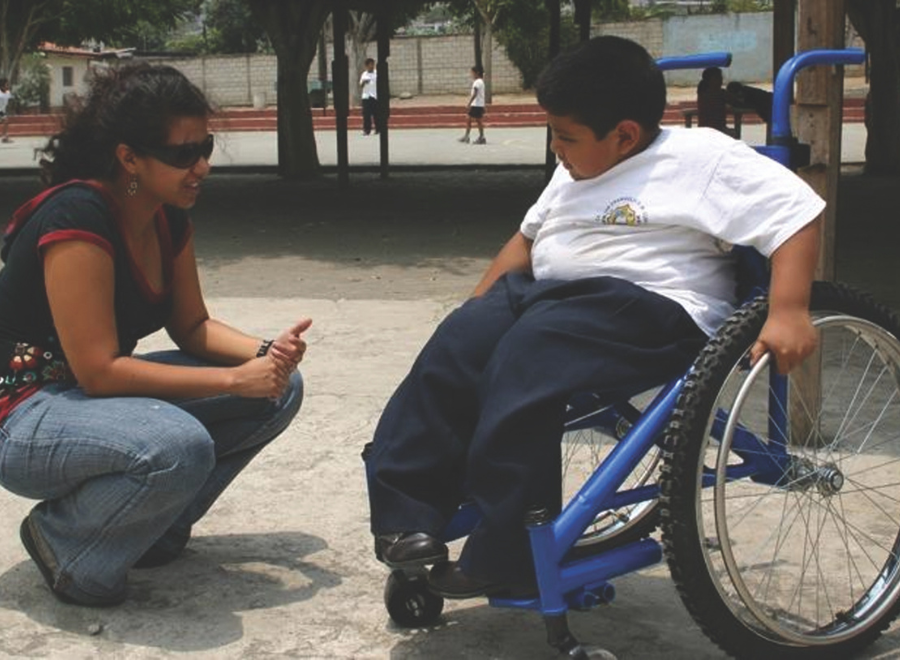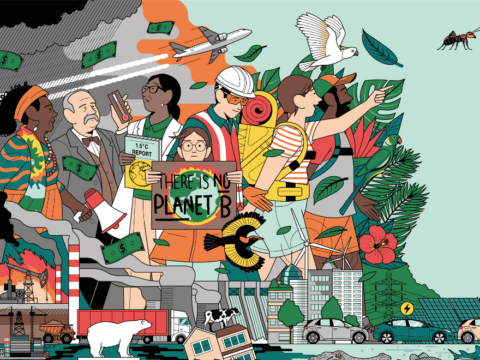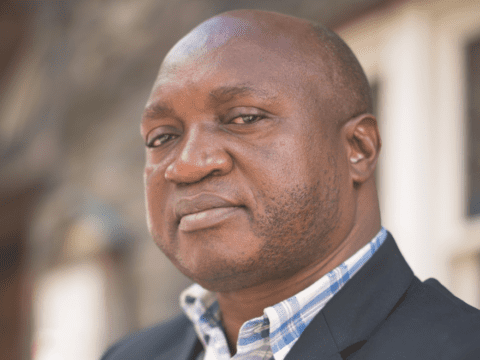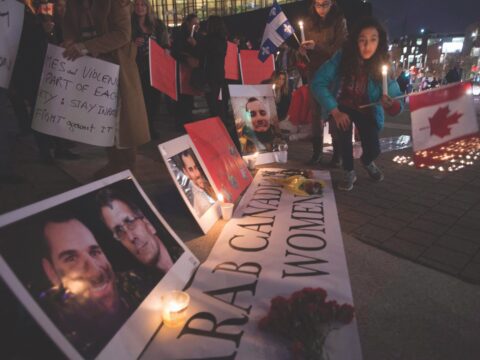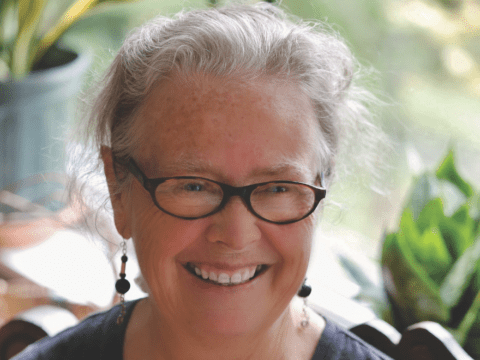Innovations are fresh, new, usually exciting and almost always entrepreneurial. Innovations are change for the better. They often start with someone asking the question, “What if?” Or better yet, “Why not?”
And one of the wonderful byproducts of innovations is that they open the window so that even more new and better ways of doing things can fly right in and brighten things up a bit. Farmers, workers, mothers, fathers, girls and boys alike — entire villages — when offered an innovation that makes life better, almost always get innovative themselves.
That child studying by the light of a solar-powered lamp in the far reaches of the Amazon might just change the world herself one day. The farmer watering his crops with an affordable new pump starts to look around and dream a bit.
With innovations come new possibilities. Read on to discover seven that are improving life in the developing world right now.
1. ECONOMY
Banking on innovation
Cellphones are ubiquitous in the developing world, for the rich and the very poor alike. Institutional banks who will do business with the poorest of the poor? Not so much.
The latest statistics, released in January of this year, record 25.3 million mobile phone subscribers in the east African nation of Kenya. “Africa is now the second-largest mobile market in the world, after Asia, and the fastest-growing mobile market in the world,” says Peter Gakure-Mwangi, a blogger who writes about the economy and trends in Kenya. “More people in Kenya have access to a mobile phone than they do to a clean toilet.”
The upward surge of mobile phone users is the same in every continent. But it’s not the cellphone itself that is the innovation here. That would be very old news.
Instead, it’s the way cellphones are being used for banking. M-PESA is a mobile phone money-transfer service developed — first and foremost — as a more efficient way for microcredit clients to repay their loans, without having to make long, expensive journeys to city centres.
M-PESA quickly grew beyond the microcredit world, however. For example, it’s become the preferred method for city-dwelling income earners to “text” funds back home to rural areas, where recipients can turn the text into instant cash through a nearby M-PESA agent.
Economists are watching. So are aid and development workers. “M-PESA is more accessible than other banking and money-transfer options in Kenya, thus even the poorest and less educated are able to run banking services using telephones,” says Richard Lankas, a senior technical specialist with World Vision Kenya.
Innovations like M-PESA can even change how aid is distributed, enabling fast and direct cash transfers in times of emergencies. “With cash, people can buy food from local markets and directly impact these local markets,” explains Lankas. And improvements in the local economy help everyone.
The ease, safety and speed of M-PESA mean that more money is changing hands more often, usually for things like school fees, food supplies and, of course, household bills.
M-PESA has been adopted in Tanzania and adapted in Afghanistan, where it is known as M-Paisa.
In 2010, M-PESA spread to South Africa. And a 2011 agreement with Western Union means that M-PESA users in Kenya can now receive mobile money from senders in 46 countries around the world, opening the doors — and virtual wallets — to even more cash flow and spinoff economic growth.
The letter “M” in M-PESA stands for mobile, while “pesa” is money in Swahili. Bringing those two together could be one of Africa’s most significant economic innovations yet.
2. AGRICULTURE
Building pumps and business
Social entrepreneurs are innovative thinkers who apply entrepreneurial principles to social problems. They use their skills, their creativity and often their marketplace experience to come up with ideas and products to help improve lives.
The Baby Elephant Pump is one of the latest examples of just that from an award-winning design lab in Burma called Proximity Designs. Conceived as an alternative to the sprinkling can, a labour-intensive method of watering crops, the pump allows for faster and more efficient irrigation.
Elephant pumps themselves are not new: they are used widely in the developing world, require few and easily located parts, and are known for being strong and reliable — just like their namesake.
But the design team at Proximity took the concept even further — and lighter — making a plastic pump that is easily manufactured, simple to use and inexpensive for poor farmers in Burma to purchase. While a metal pump can cost $100 or more, the Baby Elephant Pump sells for around $13.
The new pump has proved popular with customers, according to business magazine Fast Company: 8,000 sales in the first year, with thousands more to follow.
And selling is definitely part of the plan. Proximity Designs is a business, after all, but one geared toward creating innovative and affordable solutions for poor populations to improve their own lives. It’s a vision built on market principles: Is there a need? How can we meet it? How can we market it?
On its website, Proximity states, “All of our products are designed for extreme affordability and we use the power and reach of markets to get them to more families who need them most.”
This approach caught the eye of the U.S.-based Skoll Foundation. Created by Jeff Skoll, the first president of eBay, the foundation rewards entrepreneurial spirit and know-how for the social good, with cash injections that help social entrepreneurs go even further with their projects. When the Skoll Foundation announced Proximity as a 2012 winner, it noted that the team designs “with empathy.”
As ingenious and practical as the Baby Elephant Pump is, the biggest innovation here might be using market forces to empower the poor with dignity, excellent products and, yes, a better way to water their crops.
3. ENERGY
Rays of hope in Brazil
It is one of the world’s vexing ironies that the poorest people on the planet — many without electricity — often live in areas where the sun’s energy is the richest, the warmest and the least accessed. “Equatorial areas are rich in solar energy,” says Ottawa-based energy activist Paul McKay, “and modern solar technology allows [people] to convert the sun’s power into energy and store it in batteries.”
This is what is happening in Brazil, through the efforts of social entrepreneur Fabio Rosa, helped along by his Canadian advocate McKay, a retired investigative journalist. It was during a 2004 reporting trip to Brazil that McKay saw firsthand the life-altering impact solar energy could have on the millions of rural Brazilians who lack access to electricity. He met a tobacco-farming family in the Amazon region who had tripled their income after only a few months of living with solar power.
The new energy source gave them the ability to irrigate their other crops, powered a temperature sensor for their tobacco furnace and meant they could spend less money on wood to dry their now higher-quality product. And their kids were doing their homework by LED light instead of by the fumes of a kerosene lamp.
Rosa is determined to go where profit-minded traditional power companies will not — into the poorest, most off-the-beaten-track villages in Brazil. His idea is simple and innovative: Lease solar panels to communities for less than what they would otherwise spend on kerosene, candles and batteries — pricey items they would no longer require once solar energy was lighting up their lives. Provide high-efficiency LED lights and batteries to store the energy, as well as a water pump so the community benefits immediately. Train and hire a couple of handy locals to watch over the mostly maintenance-free solar panels.
Rosa has also pulled the international community in to help speed things along. Thanks to a meeting arranged through McKay, the Ontario-based manufacturer Canadian Solar Inc. warmed to Rosa’s vision, recently donating 560 solar panels to his Brazil project.
“It would have taken Fabio a decade to get this many panels that can supply about 1,000 families. This one donation from [Canadian Solar] will save him 10 years of scrambling for money,” says McKay.
And the families and villages who are now able to do things like pump clean water and refrigerate food and medicine quickly get innovative themselves.
“In Fabio’s project, people have devised their own ways of creating income, just through this little bit of solar energy,” says McKay, who cites solar-powered animal corrals as one example. Portable paddocks, “electrified” by solar panel energy, can help boost meat and milk production by shifting grazing animals to fresh grass as required.
“The one thing [Brazilians] have,” says McKay, “is lots of solar energy. The thing that appeals to me most is that this can be replicated and scaled up everywhere in the world where there are poor people and lots of sun. It’s not just a Brazil solution; it’s a way to alleviate poverty.”
4. MEDICINE
White vinegar to the rescue
There are 1,001 tips listed on a website dedicated to the wonders of “economical, all natural, environmentally friendly, non-toxic” white vinegar. One of the newest uses for what is sometimes called the world’s oldest ingredient hasn’t made it to that particular tip list yet. But detecting cervical cancer in women could be the lowly white vinegar’s greatest triumph yet.
The World Health Organization (WHO) reports that cervical cancer is currently the second most common cancer in women worldwide, with about 500,000 new cases and 250,000 deaths each year. The vast majority of cases — almost 80 percent — occur in the developing world, where access to Pap smears is limited. If found early, though, cancer of the cervix is one of the most treatable forms of the disease. Enter vinegar, in an important new role.
The procedure, developed at Johns Hopkins medical school and endorsed in 2010 by WHO, is as simple as brushing white vinegar on a woman’s cervix. Precancerous spots turn visibly white within a few minutes. Trained health practitioners can remove the spots immediately by freezing them off, a process known as cryotherapy.
Unlike the traditional Pap smear, which involves lab testing, this is a one-visit diagnosis and treatment scenario that works well in low-income countries. Women often have to travel long distances to see a nurse or doctor in the first place, making it harder to reach them with test results. They would also likely face huge obstacles in returning for the treatment a positive diagnosis required.
The vinegar technique has been piloted in more than 20 countries, with Thailand emerging as a leader in the field. Thailand has screened 500,000 women in 29 of 75 provinces, according to a 2011 New York Times article on the therapy. Reporter Donald G. McNeil Jr. described the procedure — officially called VIA/cryo — as having “the potential to do for poor countries what the Pap smear did for rich ones: end cervical cancer’s reign as the No.1 cancer killer of women.”
5. SANITATION
Turning on the Tippy Tap
It may have a very cute name, but the Tippy Tap helps solve one serious problem. Anyone familiar with health issues in the developing world has heard the term “preventable diseases.” Often, prevention can be found in a bar of soap, some water and some simple education around handwashing.
The Tippy Tap, promoted by Atlanta’s Center for Disease Control and Prevention (CDC), is a very simple water dispenser, with soap attached to the unit. The dispenser tips over, wetting the soap and providing a stream of water for instant handwashing.
The Tippy Tap uses much less water than a traditional tap and doles out new water every time, unlike a bowl with water set aside for handwashing.
“Tippy Taps can make handwashing with soap and water accessible to nearly anyone, anywhere, because they are easily made with free and recycled materials, don’t require access to piped water, and allow people to wash hands with a minimal volume of water (reducing the burden on users to refill the Tippy Tap),” explains Dr. Anna Bowen, a medical epidemiologist with the CDC’s Waterborne Disease Prevention Branch.
Statistics show that proper handwashing can dramatically cut down on deaths by preventable diseases, sometimes by more than 40 percent. UNICEF encourages handwashing as a way to battle the two biggest killers of children in the developing world: diarrhea and respiratory infections.
“Promoted on a wide enough scale, handwashing with soap can be thought of as a ‘do-it-yourself’ vaccine,” reports the Global Public-Private Partnership for Handwashing with Soap, an international coalition focused on hand hygiene and child health. “Ingraining the habit of handwashing could save more lives than any single vaccine or medical intervention.”
The Tippy Tap is a do-it-yourself way to make this “do-it yourself vaccine” available in places where sanitation infrastructure is lacking or absent. All a community needs is a plastic container, soap and some rope.
Originally designed by a Salvation Army doctor in Zimbabwe, the first Tippy Tap was a gourd filled with water. The device has since evolved to fit different circumstances around the world, but clean hands look just about the same anywhere.
6. EDUCATION
Water into wisdom in Bangladesh
“Flood prone” is a term often used to describe the southern Asian nation of Bangladesh. It is a country routinely hit hard by floods and monsoons, and a primary victim of climate change-related flooding. Rivers, tributaries and other waterways carve up the low-lying land.
Now those swollen waterways are being put to innovative use. Shidhulai Swanirvar Sangstha, a non-profit organization in Bangladesh, fits indigenous boats with rooftop solar panels, LED lights, computers, desks and shelves of library books. The flat-bottomed fleet of 54 vessels glide their way down winding rivers to some of Bangladesh’s most remote villages, bringing technology, health clinics, wireless Internet, schooling for children and further education for adults.
Once used mostly for transportation, boats have become all about transformation. “Boats provide maximum flexibility and reach villagers that, for logistical, social or cultural reasons, cannot access a permanent institution,” explains Abul Hasanat Mohammed Rezwan, the organization’s founder, in an e-mail interview from Bangladesh.
He points out that females in particular benefit from this floating opportunity, because in a “deeply conservative society such as Bangladesh, culture restricts the mobility of girls and women.”
The boats are also used as training grounds for alternative farming methods that minimize environmental impact. This is an essential component of the project for Rezwan, who sees the education and empowerment that happens in the dockside classrooms as part of his country’s strategy to cope with the impact of climate change.
Volunteer staff members help villagers find resources in the onboard libraries. And the organization distributes solar-powered LED lights for use at home; when the boat docks nearby, women bring the lights back for recharging.
“Our solar lantern provides families with high-quality light in the evening for children to study and women to do craftwork to earn extra income,” notes Rezwan.
Shidhulai Swanirvar Sangstha received a 2005 Access to Learning Award from the Gates Foundation for its innovation in transforming what others would see as a watery obstacle into the conduit for education and empowerment in one of the world’s poorest countries. With that award, the organization built additional library and school boats and upgraded its technology. Rezwan plans to reach another 81,500 families by introducing another
30 new boats in the next five years.
7. DISABILITY
A great reason to reinvent the wheel
Imagine, for a moment, the bumpy paths and potholed roads in many areas of the developing world. Now imagine needing a wheelchair to get around on them.
That problem presented itself to a couple of young designers in a Caltech engineering class a few years ago. Rudy Roy and Ben Sexson learned that disabled people in Guatemala face a virtually impossible cost of $400 and up to purchase a wheelchair that probably wouldn’t be any match for the rough terrain.
Mountain bikes, though, can navigate most of the world’s roughest trails. The pair began to tinker with bike parts, and after graduation they formed Intelligent Mobility International, a non-profit dedicated to designing innovative and affordable mobility devices.
IMI today offers a wheelchair with a lightweight, adjustable frame and a big set of wheels, perfect for uneven terrain. The chairs are assembled completely in Guatemala, and a quick stop at any bike repair shop usually solves any problems that pop up. The chairs cost about $150 to produce, but the team is committed to reducing costs to make the chair even more accessible.
As word gets out about the rugged wheelchair, demand for it is growing. There are, after all, 650 million people in the world with disabilities, according to the World Health Organization, and 80 percent of them live in the developing world. Moreover, WHO reports that 20 percent of the world’s poorest people are disabled.
For those with a low income and limited mobility, a durable, affordable wheelchair could put them on the road to new opportunities.
***
This story first appeared in The United Church Observer’s March 2012 issue with the title “7 innovations for a better world.”

